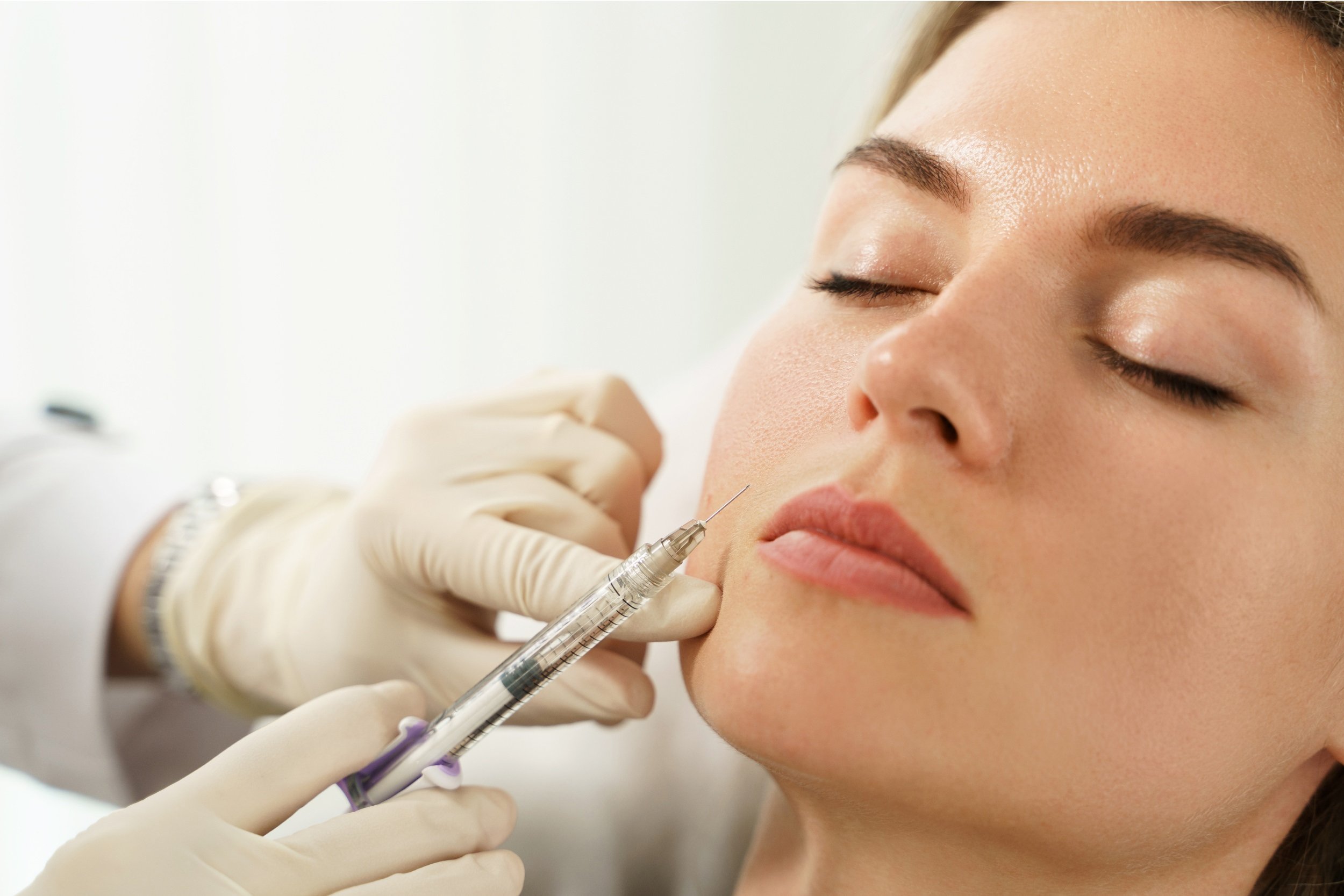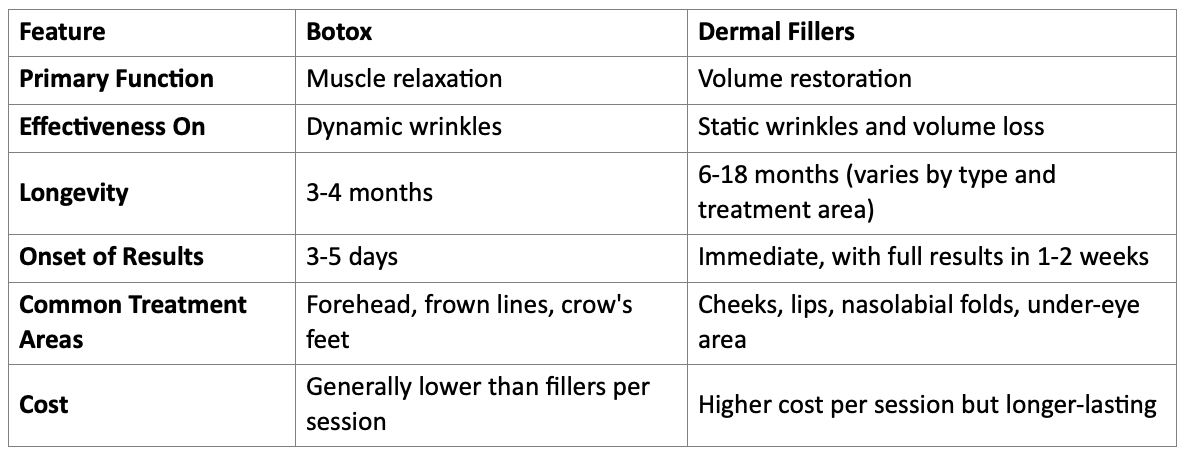Dermal Fillers vs Botox: Which Is Better?
With the rise in non-surgical cosmetic treatments, Botox and dermal fillers are two of the most popular options for achieving smoother, more youthful-looking skin. While both can help reduce the appearance of fine lines and wrinkles, they work in different ways and are suitable for different cosmetic goals. If you're considering one of these treatments but unsure which option is best for you, this guide will help you make an informed decision.
Understanding Botox and Dermal Fillers
Before we dive into the comparison, let’s clarify what each treatment is and how it works.
What is Botox?
Botox is a purified form of botulinum toxin that temporarily relaxes muscles. When injected into specific muscles, it can reduce or eliminate the appearance of dynamic wrinkles—wrinkles that are formed from repeated facial expressions, such as smiling or frowning. Botox is FDA-approved for treating frown lines, crow's feet, and forehead lines, making it ideal for smoothing expression-related wrinkles in the upper face.
How Does Botox Work?
Botox blocks nerve signals to targeted muscles, preventing them from contracting. By relaxing these muscles, Botox softens the overlying skin, reducing the appearance of wrinkles. It doesn’t add volume or alter facial structure but instead minimizes the visibility of wrinkles caused by muscle movement.
Common Botox Treatment Areas
Forehead lines - Horizontal lines that develop with eyebrow movement.
Frown lines (glabellar lines) - Vertical lines between the eyebrows.
Crow’s feet - Fine lines around the outer corners of the eyes.
What are Dermal Fillers?
Dermal fillers are gel-like substances injected beneath the skin to restore lost volume, enhance facial contours, and reduce static wrinkles (wrinkles present even without movement). They are often made from hyaluronic acid (HA), a substance naturally found in the skin that helps retain moisture and add fullness. Other types include calcium hydroxylapatite and poly-L-lactic acid, each suited to different aesthetic goals.
How Do Dermal Fillers Work?
Dermal fillers add volume to areas that have lost elasticity, plumpness, or contour over time. By filling in lines and wrinkles, they create a smoother, more youthful appearance. Unlike Botox, which affects muscle movement, fillers physically add volume and support to the skin, making them ideal for addressing deep-set lines and enhancing facial structure.
Common Dermal Filler Treatment Areas
Nasolabial folds - Lines running from the nose to the corners of the mouth.
Marionette lines - Lines that extend from the mouth to the chin.
Cheeks and jawline - Adds contour and volume to enhance facial structure.
Lips - Adds fullness and definition for a plumper look.
Under-eye hollows - Reduces dark circles and fills in sunken areas.
Botox vs. Dermal Fillers: Key Differences
Here’s a closer look at some of the essential distinctions between Botox and dermal fillers.
Pros and Cons of Botox
Pros
Fast and noticeable results - Most people start seeing effects within 3-5 days, with full results in about 2 weeks.
Minimal downtime - Botox treatments are quick, often completed in under 15 minutes.
Short-term commitment - Botox results last 3-4 months, making it a lower commitment option if you’re trying injectables for the first time.
Highly effective for dynamic wrinkles - If your primary concern is wrinkles caused by facial expressions, Botox is highly effective.
Cons
Temporary results - You’ll need to repeat treatments every 3-4 months to maintain results.
Limited use - Botox is only effective for dynamic wrinkles, so it won’t address volume loss or deep-set lines.
Risk of “frozen” appearance - In inexperienced hands, Botox injections can result in a stiff or frozen look.
Pros and Cons of Dermal Fillers
Pros
Immediate results - You’ll see a noticeable difference right away, with full effects within a couple of weeks.
Longer-lasting effects - Dermal fillers can last anywhere from 6 months to 2 years, depending on the type and area treated.
Versatility - Dermal fillers can treat a wide range of aesthetic concerns, from lip enhancement to cheek contouring.
Customizable - Fillers come in various formulas, allowing for customized treatments based on the specific area and desired look.
Cons
Higher cost per treatment - Dermal fillers tend to be more expensive than Botox per session.
Risk of swelling and bruising - There’s a chance of mild to moderate bruising or swelling around the injection site.
Possibility of lumps or uneven results - If improperly administered, fillers can create lumps or an asymmetrical appearance.
How to Choose Between Botox and Dermal Fillers
Selecting between Botox and dermal fillers largely depends on your aesthetic goals, the areas of concern, and the kind of results you’re hoping to achieve.
1. For Reducing Fine Lines and Wrinkles
Botox - Ideal for reducing dynamic wrinkles in the upper face, such as frown lines, forehead creases, and crow’s feet.
Dermal Fillers - Better suited for deeper wrinkles or folds, such as those around the mouth or nose.
2. For Volume Restoration and Contouring
Dermal Fillers are the clear choice for adding volume, particularly in areas like the cheeks, lips, and under-eye hollows. They can also improve facial contours for a more sculpted look.
3. For Subtle, Preventative Care
Botox is often chosen by younger individuals as a preventative treatment to stop wrinkles before they deepen, especially in the forehead and around the eyes.
4. If You Want Immediate Results
Both treatments offer quick results, but dermal fillers provide instant volume and smoothing, while Botox takes a few days to a week to reach full effect.
Combining Botox and Dermal Fillers
Many patients opt for a combination of Botox and dermal fillers for comprehensive rejuvenation. Known as a "liquid facelift", this approach targets both dynamic wrinkles and volume loss, creating a balanced, youthful appearance. Combining the two can address multiple areas of concern, giving patients a smoother, firmer, and more lifted look.
Safety and Side Effects
Both Botox and dermal fillers are FDA-approved and safe when administered by a qualified, experienced injector. However, like all medical procedures, there are some risks and potential side effects.
Botox Side Effects
Temporary bruising or swelling at the injection site
Headache or flu-like symptoms
Drooping of the eyelid or brow if injected improperly
Dermal Filler Side Effects
Redness, swelling, or bruising at the injection site
Formation of lumps or bumps under the skin
Allergic reactions in rare cases
Pro Tip: To minimize risks, ensure you choose a licensed, experienced provider who specializes in facial injectables and has a thorough understanding of facial anatomy.
How Much Do Botox and Dermal Fillers Cost?
The cost of Botox and dermal fillers can vary depending on factors such as the provider’s expertise, the location of the clinic, and the amount of product required. Here’s a general estimate:
Botox: Priced per unit, typically between $10 and $20 per unit. An average treatment may cost around $200 to $600, depending on the area treated.
Dermal Fillers: Cost varies by type and brand, but treatments generally range from $500 to $1,500 per syringe. The amount needed depends on the area and the desired outcome.
How to Maintain Results
Whether you choose Botox or dermal fillers, a proper skincare routine is essential for maintaining results. Here are some tips:
Protect Your Skin from the Sun - UV exposure accelerates skin aging, so always apply SPF.
Follow a Skincare Routine - Regularly use products with ingredients like retinoids, hyaluronic acid, and antioxidants to keep skin hydrated and youthful.
Stay Hydrated - Drinking water keeps your skin plump and helps fillers last longer.
Avoid Smoking - Smoking accelerates aging and can reduce the longevity of your injectables.
Final Thoughts: Which is Better, Botox or Dermal Fillers?
Ultimately, the best choice depends on your individual goals. Botox is fantastic for smoothing dynamic wrinkles and preventing future lines, making it ideal for younger patients or those looking to reduce expression lines. On the other hand, dermal fillers are excellent for restoring lost volume and filling in deeper creases, making them the go-to for more significant contouring or lifting effects.
If you’re still unsure, consult with a qualified aesthetic provider who can assess your skin and recommend the right approach. ZZ Med Spa offers personalized consultations, where we can help design a treatment plan tailored to your specific concerns, so you can achieve natural-looking, rejuvenated results.
In summary, both Botox and dermal fillers can help you look younger and more refreshed. The key is understanding what each treatment can do and selecting the option that aligns with your beauty goals. With the guidance of a skilled professional, you can make the best choice to achieve the aesthetic you desire.


